Oumuamua
Exploration
'Oumuamua — the first object known to originate outside our solar system
Discovery / Explanations of Oumuamua References
The debate over the origins and molecular structure of 'Oumuamua continued today with an announcement in The Astrophysical Journal Letters that despite earlier promising claims, the interstellar object is not made of molecular hydrogen ice after all. 1) 2)
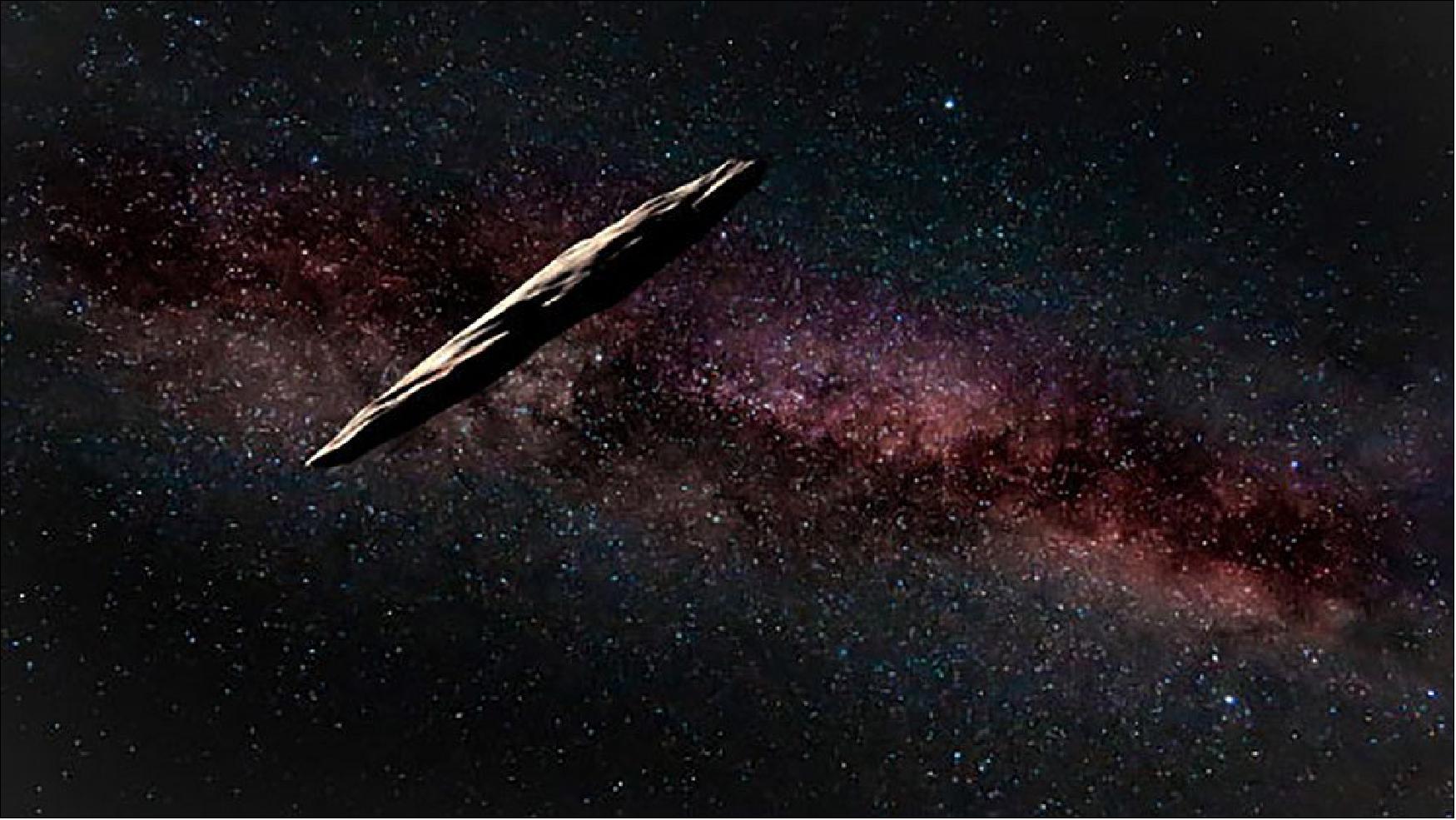
The earlier study, published by Seligman & Laughlin in 2020—after observations by the Spitzer Space Telescope set tight limits on the outgassing of carbon-based molecules—suggested that if 'Oumuamua were a hydrogen iceberg, then the pure hydrogen gas that gives it its rocket-like push would have escaped detection. But scientists at the Center for Astrophysics | Harvard & Smithsonian (CfA) and the Korea Astronomy and Space Science Institute (KASI) were curious whether a hydrogen-based object could actually have made the journey from interstellar space to our solar system.
"The proposal by Seligman and Laughlin appeared promising because it might explain the extreme elongated shape of ‘Oumuamua as well as the non-gravitational acceleration. However, their theory is based on an assumption that H2 ice could form in dense molecular clouds. If this is true, H2 ice objects could be abundant in the universe, and thus would have far-reaching implications. H2 ice was also proposed to explain dark matter, a mystery of modern astrophysics," said Dr. Thiem Hoang, senior researcher in the theoretical astrophysics group at KASI and lead author on the paper. "We wanted to not only test the assumptions in the theory but also the dark matter proposition." Dr. Avi Loeb, Frank B. Baird Professor of Science at Harvard and co-author on the paper, added, "We were suspicious that hydrogen icebergs could not survive the journey—which is likely to take hundreds of millions of years—because they evaporate too quickly, and as to whether they could form in molecular clouds."
Traveling at a blistering speed of 196,000 mph in 2017, 'Oumuamua was first classified as an asteroid, and when it later sped up, was found to have properties more akin to comets. But the 0.2 km radius interstellar object didn't fit that category, either, and its point of origin has remained a mystery. Researchers focused on the giant molecular cloud (GMC) W51—one of the closest GMCs to Earth at just 17,000 light years away—as a potential point of origin for 'Oumuamua, but hypothesize that it simply could not have made the journey intact. "The most likely place to make hydrogen icebergs is in the densest environments of the interstellar medium. These are giant molecular clouds," said Loeb, confirming that these environments are both too far away and are not conducive to the development of hydrogen icebergs.
An accepted astrophysical origin for solid objects is growth by sticky collisions of dust, but in the case of a hydrogen iceberg, this theory could not hold together. "An accepted route to form a km-sized object is first to form grains of micron-size, then such grains grow by sticky collisions," said Hoang. "However, in regions with high gas density, collisional heating by gas collisions can rapidly sublimate the hydrogen mantle on the grains, preventing them from growing further."
Although the study explored destruction of H2 ice by multiple mechanisms including interstellar radiation, cosmic rays, and interstellar gas, sublimation due to heating by starlight has the most destructive effect, and according to Loeb, "Thermal sublimation by collisional heating in GMCs could destroy molecular hydrogen icebergs of ‘Oumuamua-size before their escape into the interstellar medium." This conclusion precludes the theory that ‘Oumuamua journeyed to our solar system from a GMC, and further precludes the proposition of primordial snowballs as dark matter. Evaporative cooling in these situations does not reduce the role of thermal sublimation by starlight in the destruction of H2 ice objects.
Oumuamua first gained notoriety in 2017 when it was discovered screaming through space by observers at Haleakalā Observatory, and has since been the subject of ongoing studies. "This object is mysterious and difficult to understand because it exhibits peculiar properties we have never seen from comets and asteroids in our solar system," said Hoang.
While the nature of the interstellar traveler is currently an unsolved mystery, Loeb suggests it won't remain so for much longer, especially if it's not alone. "If 'Oumuamua is a member of a population of similar objects on random trajectories, then the Vera C. Rubin Observatory (VRO), which is scheduled to have its first light next year, should detect roughly one 'Oumuamua-like object per month. We will all wait with anticipation to see what it will find."
Overview
• March 16, 2021: In 2017, the first interstellar object from beyond our solar system was discovered via the Pan-STARRS astronomical observatory in Hawaii. It was named ‘Oumuamua, meaning "scout" or "messenger" in Hawaiian. The object was like a comet, but with features that were just odd enough to defy classification. 3)
- Two Arizona State University astrophysicists, Steven Desch and Alan Jackson of the School of Earth and Space Exploration, set out to explain the odd features of ‘Oumuamua and have determined that it is likely a piece of a Pluto-like planet from another solar system. Their findings have been recently published in a pair of papers (part I and part II) in the AGU Journal of Geophysical Research: Planets. 4) 5)
- "In many ways ‘Oumuamua resembled a comet, but it was peculiar enough in several ways that mystery surrounded its nature, and speculation ran rampant about what it was," said Desch, who is a professor in the School of Earth and Space Exploration.
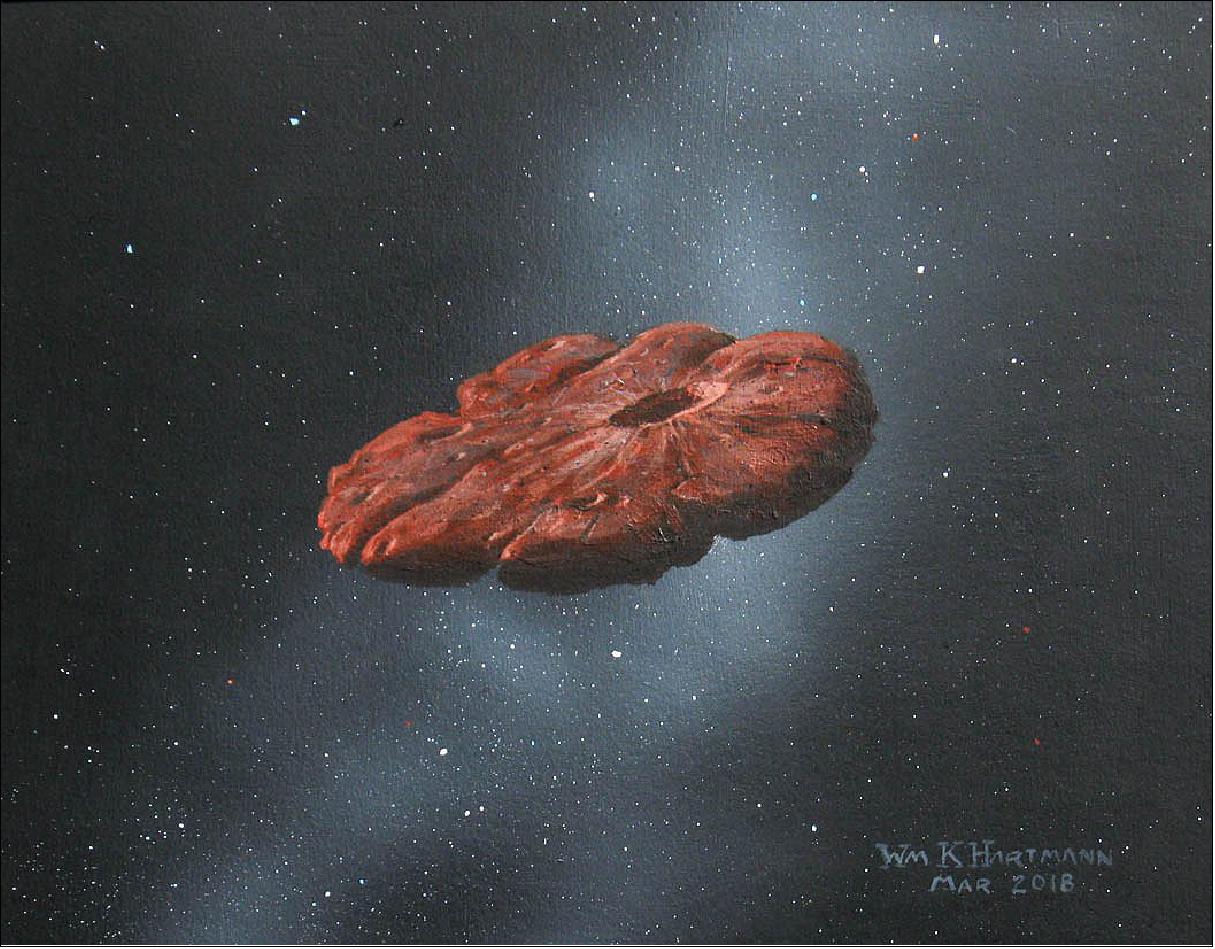
- From observations of the object, Desch and Jackson determined several characteristics of the object that differed from what would be expected from a comet.
- In terms of speed, the object entered the solar system at a velocity a bit lower than would be expected, indicating that it had not been traveling in interstellar space for more than a billion years or so. In terms of size, its pancake shape was also more flattened than any other known solar system object.
- They also observed that while the object acquired a slight push away from the sun (a "rocket effect" common in comets as sunlight vaporizes the ices they are made of), the push was stronger than could be accounted for. Finally, the object lacked a detectable escaping gas, which is usually depicted visibly by a comet's tail. In all, the object was very much like a comet, but unlike any comet that had ever been observed in the solar system.
- Desch and Jackson then hypothesized that the object was made of different ices and they calculated how quickly these ices would sublimate (passing from a solid to a gas) as ‘Oumuamua passed by the sun. From there, they calculated the rocket effect, the object's mass and shape, and the reflectivity of the ices.
- "That was an exciting moment for us," Desch said. "We realized that a chunk of ice would be much more reflective than people were assuming, which meant it could be smaller. The same rocket effect would then give 'Oumuamua a bigger push, bigger than comets usually experience."
Figure 3: The first interstellar object from beyond our solar system was discovered via the Pan-STARRS astronomical observatory in Hawaii in 2017 and named ‘Oumuamua. It was like a comet, but with features that were just odd enough to defy classification. ASU astrophysicists, Steven Desch and Alan Jackson, set out to explain the odd features of ‘Oumuamua and have determined that it is likely a piece of a Pluto-like planet from another solar system (video credit: ASU School of Earth and Space Exploration)
- Desch and Jackson found one ice in particular — solid nitrogen — that provided an exact match to all the object's features simultaneously. And since solid nitrogen ice can be seen on the surface of Pluto, it is possible that a cometlike object could be made of the same material.
- "We knew we had hit on the right idea when we completed the calculation for what albedo (how reflective the body is) would make the motion of ‘Oumuamua match the observations," said Jackson, who is a research scientist and an Exploration Fellow at ASU. "That value came out as being the same as we observe on the surface of Pluto or Triton, bodies covered in nitrogen ice."
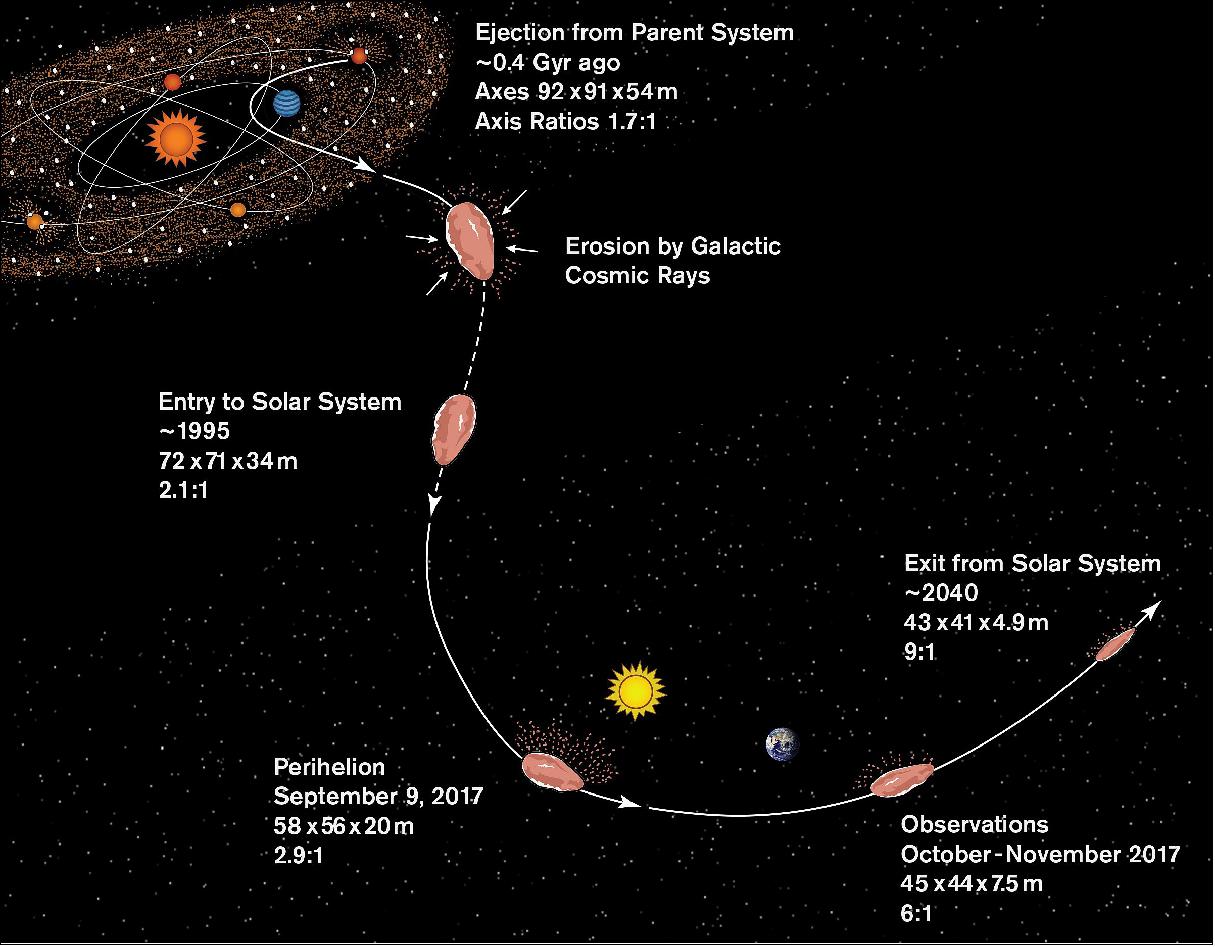
- They then calculated the rate at which chunks of solid nitrogen ice would have been knocked off the surfaces of Pluto and similar bodies early in our solar system's history. And they calculated the probability that chunks of solid nitrogen ice from other solar systems would reach ours.
- "It was likely knocked off the surface by an impact about half a billion years ago and thrown out of its parent system," Jackson said. "Being made of frozen nitrogen also explains the unusual shape of ‘Oumuamua. As the outer layers of nitrogen ice evaporated, the shape of the body would have become progressively more flattened, just like a bar of soap does as the outer layers get rubbed off through use."
Could ‘Oumuamua Have Been Alien Technology?
- Although ‘Oumuamua's cometlike nature was quickly recognized, the inability to immediately explain it in detail led to speculation that it is a piece of alien technology, as in the recently published book "Extraterrestrial: The First Signs of Intelligent Life Beyond Earth" by Avi Loeb of Harvard University.
- This has sparked a public debate about the scientific method and the responsibility of scientists not to jump to unwarranted conclusions.
- "Everybody is interested in aliens, and it was inevitable that this first object outside the solar system would make people think of aliens," Desch said. "But it's important in science not to jump to conclusions. It took two or three years to figure out a natural explanation — a chunk of nitrogen ice — that matches everything we know about ‘Oumuamua. That's not that long in science, and far too soon to say we had exhausted all natural explanations."
- Although there is no evidence that it is alien technology, as a fragment of a Pluto-like planet, ‘Oumuamua has provided scientists with a special opportunity to look at extrasolar systems in a way that they have not been able to before. As more objects like ‘Oumuamua are found and studied, scientists can continue to expand our understanding of what other planetary systems are like and the ways in which they are similar to, or different from, our own solar system.
- "This research is exciting in that we've probably resolved the mystery of what 'Oumuamua is and we can reasonably identify it as a chunk of an ‘exo-Pluto,' a Pluto-like planet in another solar system," Desch said. "Until now, we've had no way to know if other solar systems have Pluto-like planets, but now we have seen a chunk of one pass by Earth."
- Desch and Jackson hope that future telescopes, like those at the Vera Rubin Observatory/Large Synoptic Survey Telescope in Chile, which will be able to survey the entire southern sky on a regular basis, will be able to start finding even more interstellar objects that they and other scientists can use to further test their ideas.
- "It's hoped that in a decade or so we can acquire statistics on what sorts of objects pass through the solar system, and if nitrogen ice chunks are rare or as common as we've calculated," Jackson said. "Either way, we should be able to learn a lot about other solar systems, and whether they underwent the same sorts of collisional histories that ours did."
• February 6, 2021: Discovering there's intelligent life beyond our planet could be the most transformative event in human history— but what if scientists decided to collectively ignore evidence suggesting it already happened? 6)
- That's the premise of a new book by a top astronomer, who argues that the simplest and best explanation for the highly unusual characteristics of an interstellar object that sped through our solar system in 2017 is that it was alien technology.
- Sound kooky? Avi Loeb says the evidence holds otherwise, and is convinced his peers in the scientific community are so consumed by groupthink they're unwilling to wield Occam's razor.
- Loeb's stellar credentials—he was the longest-serving chair of astronomy at Harvard, has published hundreds of pioneering papers, and has collaborated with greats like the late Stephen Hawking—make him difficult to dismiss outright.
- "Thinking that we are unique and special and privileged is arrogant," he told AFP (Agence France-Presse) in a video call.
- "The correct approach is to be modest and say: 'We're nothing special, there are lots of other cultures out there, and we just need to find them.'"
Mysterious Visitor
- Loeb, 58, lays out the argument for the alien origins of the object named 'Oumuamua—"scout" in Hawaiian— in "Extraterrestrial: The First Sign of Intelligent Life Beyond Earth."
- The facts are as follows.
- In October 2017, astronomers observed an object moving so quickly, it could only have come from another star—the first recorded interstellar interloper.
- It didn't seem to be an ordinary rock, because after slingshotting around the Sun, it sped up and deviated from the expected trajectory, propelled by a mysterious force.
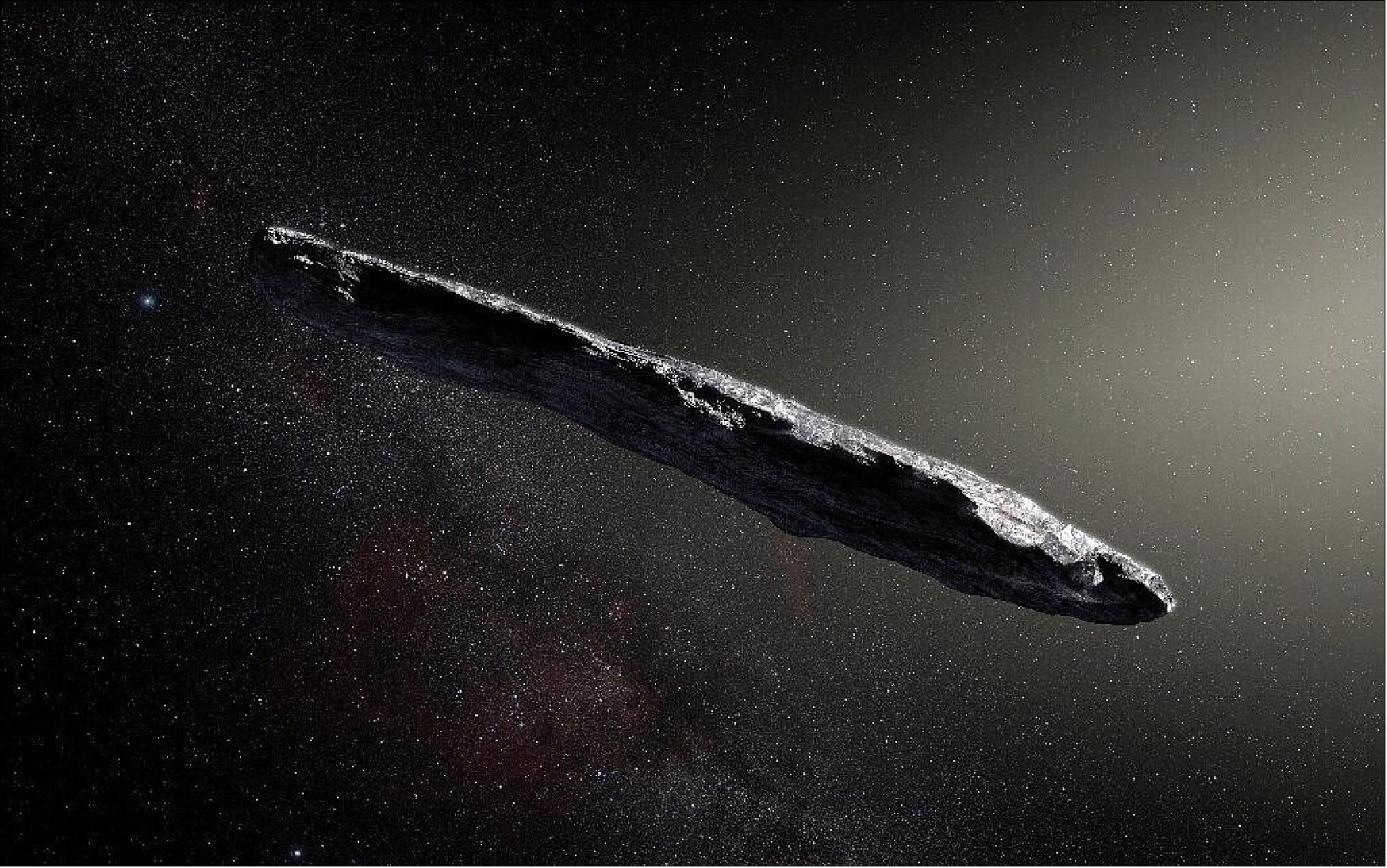
- This could be easily explained if it was a comet expelling gas and debris—but there was no visible evidence of this "outgassing."
- The traveler also tumbled in a strange way—as inferred by how it got brighter and dimmer in scientists' telescopes, and it was unusually luminous, possibly suggesting it was made from a bright metal.
- In order to explain what happened, astronomers had to come up with novel theories, such as that it was made of hydrogen ice and would therefore not have visible trails, or that it disintegrated into a dust cloud.
- "These ideas that came to explain specific properties of 'Oumuamua always involve something that we have never seen before," said Loeb.
- "If that's the direction we are taking, then why not contemplate an artificial origin?"
Sailing on Light
- 'Oumuamua was never photographed close-up during its brief sojourn—we only learned of its existence once it was already on its way out of our solar system.
- There are two shapes that fit the peculiarities observed—long and thin like a cigar, or flat and round like a pancake, almost razor thin.
- Loeb says simulations favor the latter, and believes the object was deliberately crafted as a light sail propelled by stellar radiation.
- Another oddity was the way the object moved—compounding the strangeness of its passage.
- Before encountering our Sun, 'Oumuamua was "at rest" relative to nearby stars—statistically very rare. Rather than think of it as a vessel hurtling through space, from the object's perspective, our solar system slammed into it.
- "Perhaps 'Oumuamua was like a buoy resting in the expanse of the universe," writes Loeb.
- Like a trip wire left by an intelligent lifeform, waiting to be triggered by a star system.
Uniting Humanity
- Loeb's ideas have placed him at odds with fellow astronomers.
- Writing in Forbes, astrophysicist Ethan Siegel called Loeb a "once-respected scientist" who, having failed to convince his peers of his arguments, had taken to pandering to the public.
- Loeb, for his part, protests a "culture of bullying" in the academy that punishes those who question orthodoxy—just as Galileo was punished when he proposed the Earth was not the center of the universe.
- Compared to speculative yet respected branches of theoretical physics—such as looking for dark matter or multiverses—the search for alien life is a far more commonsense avenue to pursue, he said.
- That's why Loeb's pushing for a new branch of astronomy, "space archaeology," to hunt for the biological and technological signatures of extraterrestrials.
- "If we find evidence for technologies that took a million years to develop, then we can get a shortcut into these technologies, we can employ them on Earth," said Loeb, who spent his childhood on an Israeli farm reading philosophy and pondering life's big questions.
- Such a discovery could also "give us a sense that we are part of the same team" as humanity confronts threats ranging from climate change to nuclear conflict.
- "Rather than fight each other like nations do very often, we would perhaps collaborate."
• August 19, 2020: 'Oumuamua—a mysterious, interstellar object that crashed through our solar system two years ago—might in fact be alien technology. That's because an alternative, non-alien explanation might be fatally flawed, as a new study argues. 7)
- But most scientists think the idea that we spotted alien technology in our solar system is a long shot.
- In 2018, our solar system ran into an object lost in interstellar space. The object, dubbed 'Oumuamua, seemed to be long and thin—cigar-shaped—and tumbling end over end. Then, close observations showed it was accelerating, as if something were pushing on it. Scientists still aren't sure why.
- One explanation? The object was propelled by an alien machine, such as a lightsail—a wide, millimeter-thin machine that accelerates as it's pushed by solar radiation. The main proponent of this argument was Avi Loeb, a Harvard University astrophysicist.
- Most scientists, however, think 'Oumuamua's wonky acceleration was likely due to a natural phenomenon. In June, a research team proposed that solid hydrogen was blasting invisibly off the interstellar object's surface and causing it to speed up.
- Now, in a new paper published Monday (Aug. 17) in The Astrophysical Journal Letters, Loeb and Thiem Hoang, an astrophysicist at the Korea Astronomy and Space Science Institute, argue that the hydrogen hypothesis couldn't work in the real world—which would mean that there is still hope that our neck of space was once visited by advanced aliens—and that we actually spotted their presence at the time.
- Here's the problem with 'Oumuamua: It moved like a comet, but didn't have the classic coma, or tail, of a comet, said astrophysicist Darryl Seligman, an author of the solid hydrogen hypothesis, who is starting a postdoctoral fellowship in astrophysics at the University of Chicago.
- 'Oumuamua was the first object ever seen flying into our solar system and back out again. That's opposed to most solar system objects that turn circles around the sun, never leaving the celestial neighborhood. Its journey and the fact that it was accelerating suggested 'Oumuamua, which is estimated to be about 1,300 to 2,600 feet (400 to 800 meters) long, was a comet. And yet, "there was no 'coma' or outgassing detected coming from the object," Seligman said. Normally, comets come from regions more distant from the sun than asteroids, and ice on their surface turns straight into gas as they approach the sun, leaving behind a trail of gas, or what we see as a beautiful comet tail, Seligman said.
- That outgassing changes how the comet moves through space, he said. It's a bit like a very slow rocket engine: The sun strikes the comet, the warmest part of the comet bursts with gas, and that gas flowing away from the comet sends it tumbling faster and faster away from the sun.
- In a paper published June 9 in The Astrophysical Journal Letters, Seligman and Yale astrophysicist Gregory Laughlin proposed that the object was a comet made up partly or entirely of molecular hydrogen—lightweight molecules composed of two hydrogen atoms (H2).
- H2 gas freezes into a puffy, low-density solid only when it's very cold—minus 434.45 degrees Fahrenheit (minus 259.14 degrees Celsius, or just 14.01 degrees above absolute zero) in Earth's atmosphere. Researchers had already proposed the existence of "hydrogen icebergs" out in the very cold reaches of space, Laughlin and Seligman wrote in the study. And outgassing hydrogen wouldn't be visible from Earth—meaning it wouldn't leave behind a visible comet tail.
- The numbers worked out neatly; while a few other substances (like solid neon) could potentially explain the coma-free acceleration, hydrogen was the best match for the data.
- But in their new paper, Hoang and Loeb respond to this idea and argue that the hydrogen iceberg explanation has a basic problem: Comets form when icy grains of dust bump into each other in space and form clumps, and then those clumps attract more dust and other clumps. And comets are like snowmen: they survive only as long as they don't melt.
- The stickiness that helps form comets is similar to the stickiness of ice cubes coming straight out of a cold freezer. Leave an ice cube on the counter for a minute or two, let its surface warm up a bit, and it won't feel sticky anymore. A thin film of liquid water on its surface makes it slippery.
- Hoang and Loeb argued that even starlight in the coldest parts of space would warm up small chunks of solid hydrogen before they could clump together and form a comet of 'Oumuamua's large scale. And more importantly, the trek from the nearest "giant molecular cloud"—a dusty, gassy region of space where hydrogen icebergs are thought to form—is far too long. A hydrogen iceberg travelling hundreds of millions of years through interstellar space would have fallen apart, cooked by starlight.
- Seligman said that Loeb's analysis was correct that no hydrogen comet would survive such a long trip."Hydrogen icebergs don't live that long in the galaxy.," he said. "And you definitely don't have time to get all the way from [the nearest] giant molecular cloud."
- The theory only works if 'Oumuamua is just 40 million years old, he said. Over that time frame, outgassing could have molded the comet's oblong shape without destroying it entirely.
- He pointed to a paper published in April in The Astronomical Journal, which proposed a number of nearby origin points for 'Oumuamua.
- The paper's authors didn't nail down the comet's home entirely, which would be impossible, they said. 'Oumuamua was hardly moving when it arrived in our sun's gravity well, which makes tracking the comet through space tricky. But the researchers looked at what else passed through the Milky Way neighborhood that our sun is now passing through in recent cosmic history. They landed on two groups of young stars, the Carina and Columba moving groups, said Tim Hallatt, a graduate student and astrophysicist at McGill University in Montreal, and lead author of the paper published in April.
- They all formed around 30 million to 45 million years ago in a cloud of gas that then dispersed. That small, dissipated cloud of molecular gas, with just a few young stars, is one where hydrogen icebergs might form, Hallatt said.
- "There are many processes that can eject 'Oumuamua-type objects from young stars in moving groups—like gravitational nudges between stars in the group, planet formation, or as Seligman and Laughlin 2020 argue, the molecular clouds that create the stars in the first place," Hallatt told Live Science.
- All three papers fit neatly together if you assume 'Oumuamua was a hydrogen iceberg that originated in Carina or Columba, Hallatt added.
- "Seligman & Laughlin's idea could work here because H2 objects should have a short lifetime in the galaxy (as Loeb correctly concludes), and an origin in Carina or Columba would make it young enough to survive its journey," he said.
- Loeb, however, disagrees.
- "Shortening the distance that that H2 iceberg needs to travel does not solve the problems we outline in our paper, because the H2 iceberg would have formed when its parent planetary system formed, billions of years ago," and in those eons, the iceberg would have evaporated, he told Live Science in an email.
- Loeb also said that hydrogen icebergs are expected to come from giant molecular clouds, not parts of space like Carina or Columba. And he reiterated that no hydrogen iceberg could survive the trek from the nearest giant molecular cloud.
- Asked if there is a clear leading candidate explanation for 'Oumuamua's acceleration, Loeb referred Live Science to a not-yet-released book he authored called "Extraterrestrial: The First Sign of Intelligent Life Beyond Earth," due for publication in January.
• April 13, 2020: A close encounter with another star may have torn the cigar-shaped interstellar visitor ‘Oumuamua from its parent body, flinging it toward our solar system. 8)
- One of the weirdest objects ever discovered in our solar system — the alien space rock ‘Oumuamua — is still sparking debates more than two years after its discovery. And, most recently, the conversation has shifted to whether the cosmic visitor could be a fragment ripped from a larger world.
- In 2017, the Pan-STARRS asteroid-hunting telescope in Hawaii spotted an object moving at a breathtaking pace of 54 miles (87 km/s) per second. But, unlike most comets and asteroids before it, ‘Oumuamua would only approach our Sun once before continuing its journey through space. This made it the first known interstellar object to have passed through our solar system.
- Scientists named the alien space rock ‘Oumuamua, which roughly translates as "messenger from afar arriving first" in Hawaiian. And though astronomers agree that ‘Oumuamua visited our solar system from another star, that's about where the agreement ends.
- Is it an alien asteroid, an alien comet, or even an alien spaceship?
- Now, a pair of astronomers have used complex computer modeling to explain ‘Oumuamua's combination of strange properties, finding the space rock may be a small shard ripped from a larger parent body.
- Their models suggest that when an object — anything from a comet to a super-Earth — passes too close to its star, intense tidal forces can cause heated fragments to slough off. These melted shards then refreeze, locking in their unique shapes.
- If these astronomers are right, then we should expect to spot plenty of oddly shaped worlds like ‘Oumuamua in the coming years.
- "We anticipate many more interstellar visitors with similar traits to ‘Oumuamua will be discovered by future observation," says study author Yun Zhang from the National Astronomical Observatories of the Chinese Academy of Sciences.
- The new findings were published Monday in the journal Nature Astronomy.
'Oumuamua: Asteroid or Comet?
- Astronomers expected the first interstellar object they'd discover would be an alien comet. This is because comets orbit in the outskirts of star systems, and stars pass relatively near each other somewhat frequently. So, when two stars fly by each other, the gravitational interaction can rip comets from their loosely tethered orbits, flinging them out into space.
- This ejection mechanism was further supported last year when astronomers discovered the interstellar comet 2I/Borisov, which looks reassuringly like the "dirty snowballs" found in our own solar system. It also exhibited a conventional cometary tail — the extended, fuzzy line of sublimated gas and ice that streams from comets as they approach the Sun.
- But ‘Oumuamua left astronomers with more confusing hints about its nature and history. Instead of growing an icy tail, this alien space rock looked relatively dry. It also appeared surprisingly dense and rocky.
- Its shape was even more perplexing. Most space rocks in our solar system are shaped something like a potato — or, in the case of Arrokoth, like two of them smashed together. But ‘Oumuamua is long and stretched out, more like a cigar.
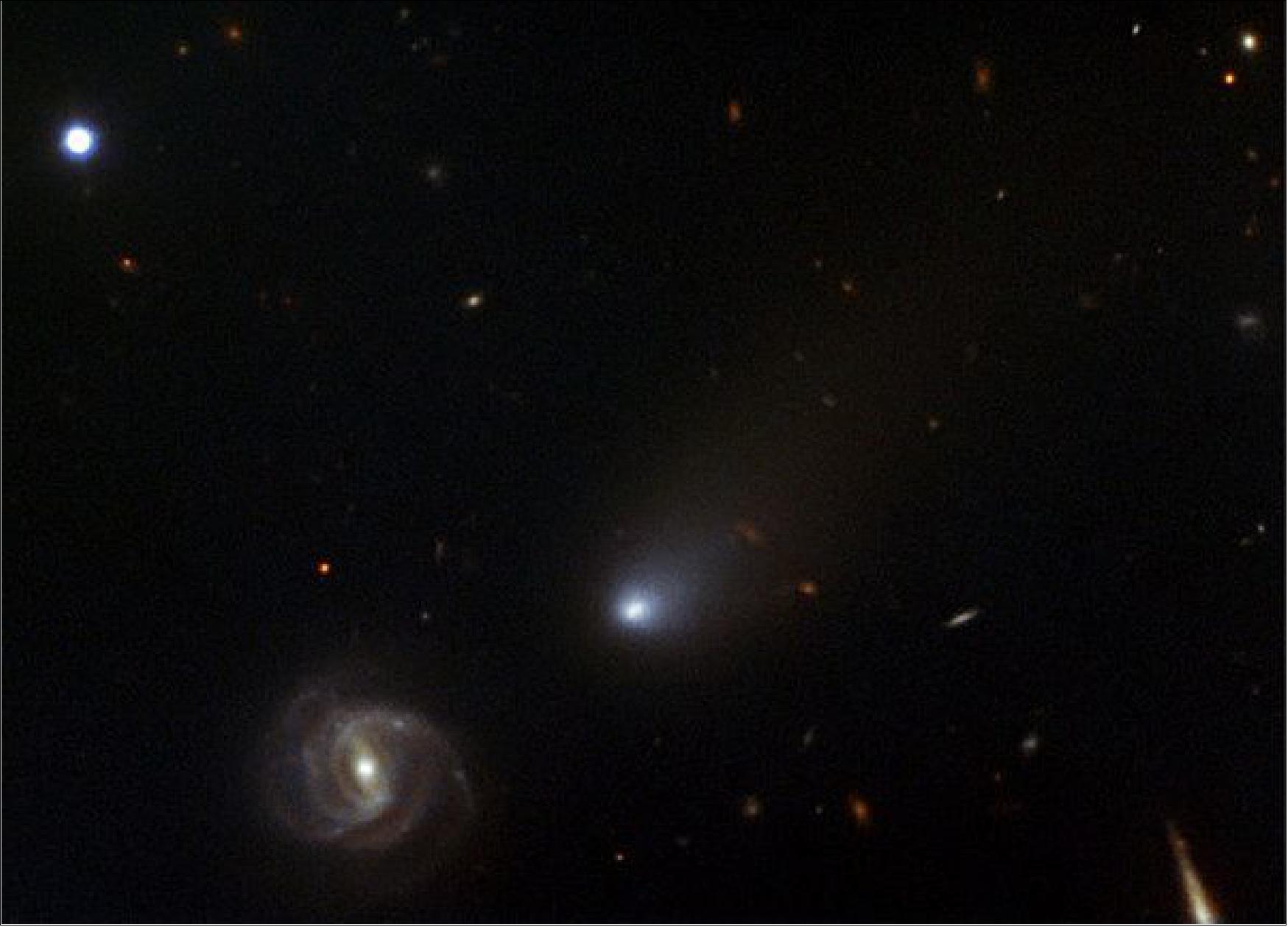
Sand Castles Among the Stars
- Zhang and study co-author Douglas Lin from the University of California, Santa Cruz, set out to explain ‘Oumuamua's weird properties. They simulated what would happen as an object flew extremely close to its home star. Their models showed that the tidal forces could literally shred it into long fragments before chucking them out into space.
- The authors say that you can imagine planetary bodies as sand castles floating in space. Much like children on the beach molding castles from many grains of sand, even modest worlds are built from many smaller pieces that are held together by gravity.
- And when an outside force acting on a planetary grain grows stronger than the gravity binding it to the parent body, that smaller piece is yanked from the whole. This is what happens when an object ventures too close to a star. Astronomers previously saw the process unfold when comet Shoemaker-Levy 9 was ripped apart by Jupiter.
- "The near and far parts of the planetary body are pulled apart from each other by the star's tidal forces, forming an elongated band of ‘sand particles,'" Zhang says, extending the analogy. "At the same time, since the body is so close to the star, some of its surface melts and freezes after it flies away. This process glues the surface ‘sand particles' together, and helps to form elongated fragments."
- And according to the research, ‘Oumuamua could very well be one such elongated fragment.
- The researchers aren't the first to propose an idea like this, however. Previous modeling work published by astronomer Sean Raymond of Laboratoire d'Astrophysique de Bordeaux in Bordeaux, France, had already used computer models to show that ‘Oumuamua could be a shredded chunk of planetesimal created during the formation of a fledgling planetary system.
- But not everyone is convinced by the argument.
The Debate Continues
- Karen Meech, an astronomer at the University of Hawai‘i who has studied ‘Oumuamua but wasn't involved in this research, says she still believes the space rock has to be a comet. Part of why she thinks that is because one piece of evidence hinting that the space rock is an asteroid could simply be a dearth of observations.
- She points out that ‘Oumuamua's high-speed trip through the solar system was too quick for astronomers to get a detailed look at the object.
- "Most of the observations of ‘Oumuamua had to occur within a one-week period, and we simply did not have the ability to detect water," she says. "That isn't a lack of water. We just didn't have the sensitivity to see it."
- And there's another outstanding property these researchers haven't explained yet, she says. ‘Oumuamua's movement through our solar system implied it was being driven by more than just gravity — like a comet whose direction is slightly changed by the force of gases streaming off of it.
- "I think it absolutely is a comet," Meech says. "The non-gravitational motion that our group detected was super strong, and there's no other way to maintain it except for outgassing. There's no other explanation."
- Because of ‘Oumuamua's incredible speed, even the fastest spaceship humanity has ever built, NASA's Parker Solar Probe, couldn't catch it. As quickly as it came, the alien interloper was gone, never to be seen again.
- "We will never know for sure where ‘Oumuamua came from or where it was created, and I've been very impressed with the models and the way people have tried to explain it," Meech says. "I don't think it proves anything."
- However, future observations still could help resolve the argument. If Zhang and Lin are right, interstellar asteroids may be even more common than interstellar comets, the authors say. These alien asteroids would be relatively small and lack the comas of comets, which would make them much harder to detect while they're passing through our solar system. However, new cutting-edge telescopes, like the Vera C. Rubin Observatory being built in Chile, could spot them.
- "'Oumuamua is just the tip of the iceberg," Lin said in a media release. "We anticipate many more interstellar visitors with similar traits will be discovered by future observation."
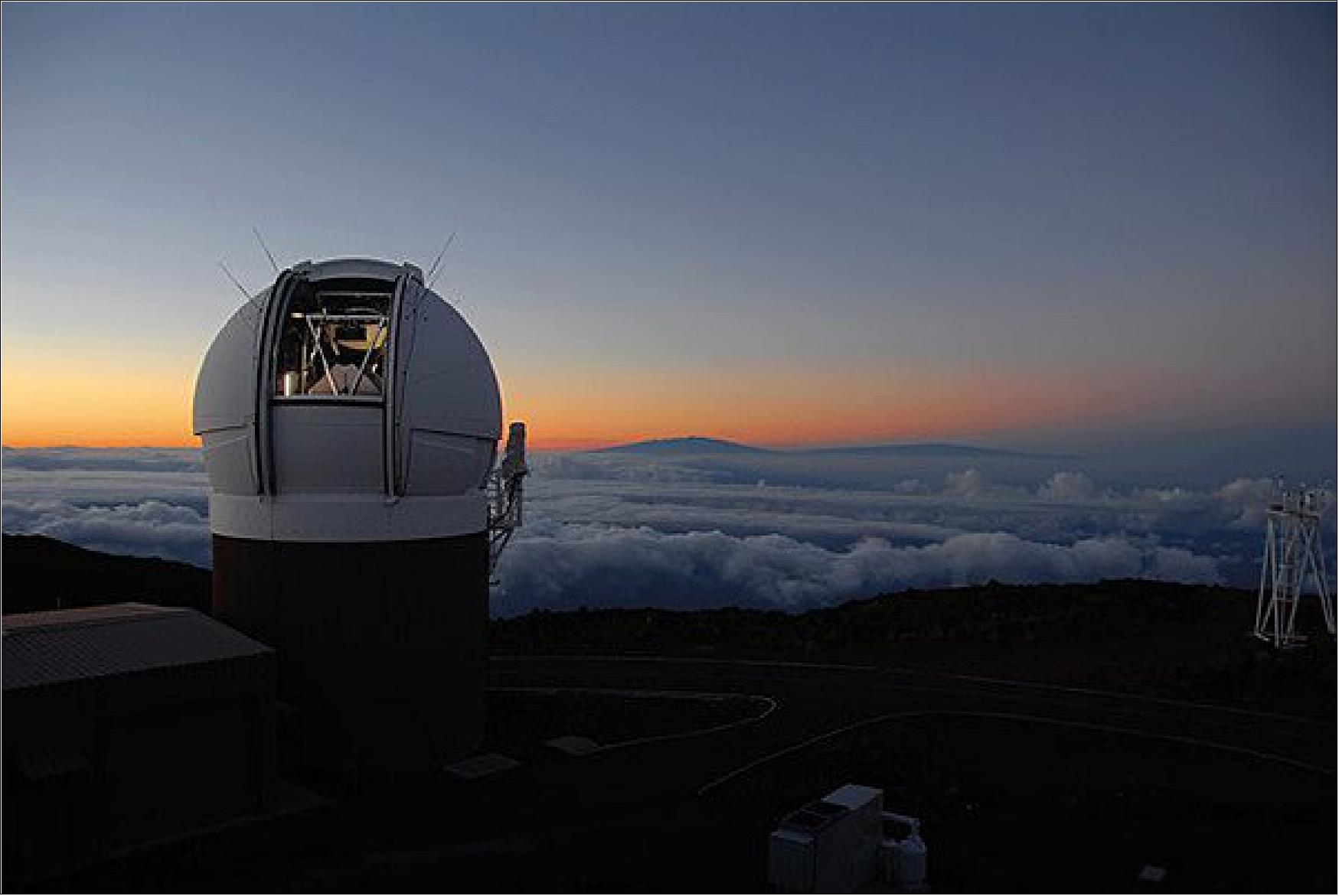
• July 1, 2019: On October 19, 2017, astronomers discovered the first known interstellar object to visit our solar system. First spotted by the Panoramic Survey Telescope and Rapid Response System 1 (Pan-STARRS1) telescope located at the University of Hawaii's Haleakala Observatory, the object defied easy description, simultaneously displaying characteristics of both a comet and an asteroid. 9)
- Astronomers formally named the object 1I/2017 U1 and appended the common name 'Oumuamua, which roughly translates to "scout" in Hawaiian. Researchers from around the world raced to collect as much data as possible before 'Oumuamua traveled beyond the reach of Earth's telescopes. In all, they had only a few weeks to observe the strange visitor.
- Early reports of 'Oumuamua's odd characteristics led some to speculate that the object could be an alien spacecraft, sent from a distant civilization to examine our star system. But a new analysis co-led by Matthew Knight, an associate research scientist in the University of Maryland Department of Astronomy, strongly suggests that 'Oumuamua has a purely natural origin. The research team reported their findings in the July 1, 2019, issue of the journal Nature Astronomy. 10)
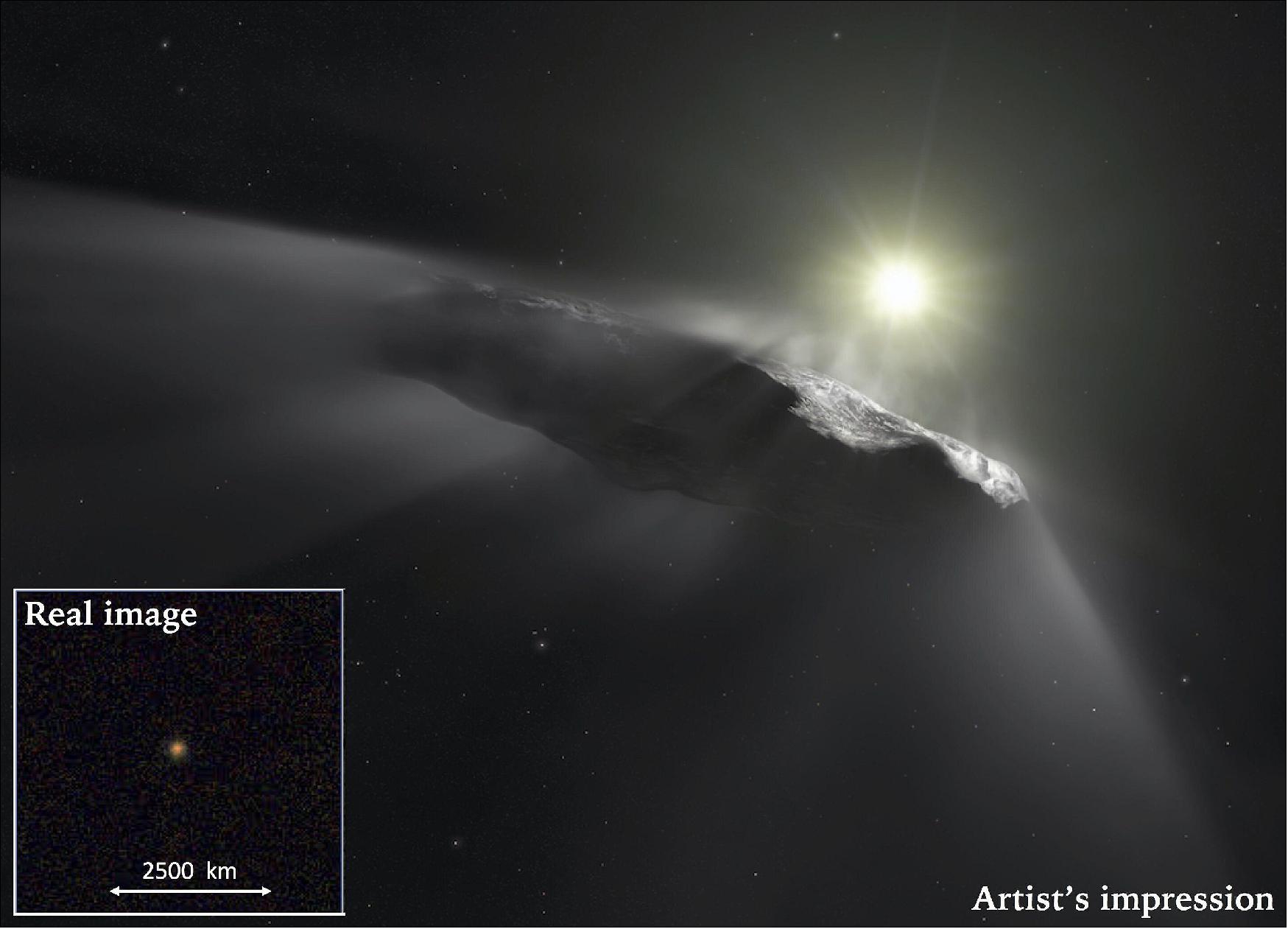
- "We have never seen anything like 'Oumuamua in our solar system. It's really a mystery still," Knight said. "But our preference is to stick with analogs we know, unless or until we find something unique. The alien spacecraft hypothesis is a fun idea, but our analysis suggests there is a whole host of natural phenomena that could explain it."
- As Knight and his colleagues summarized in their study, 'Oumuamua is red in color, similar to many small objects observed in our solar system. But that's where the familiarity ends.
- 'Oumuamua likely has an elongated, cigarlike shape and an odd spin pattern—much like a soda bottle laying on the ground, spinning on its side. According to Knight, its motion through our solar system is particularly puzzling. While it appeared to accelerate along its trajectory—a typical feature of comets—astronomers could find no evidence of the gaseous emissions that typically create this acceleration.
- "The motion of 'Oumuamua didn't simply follow gravity along a parabolic orbit as we would expect from an asteroid," Knight said. "But visually, it hasn't ever displayed any of the cometlike characteristics we'd expect. There is no discernable coma—the cloud of ice, dust and gas that surrounds active comets—nor a dust tail or gas jets."
- Knight worked with Alan Fitzsimmons, an astronomer at Queen's University Belfast in Northern Ireland, to assemble a team of 14 astronomers hailing from the U.S. and Europe. The International Space Science Institute in Bern, Switzerland, served as a virtual home base for the collaboration.
- "We put together a strong team of experts in various different areas of work on 'Oumuamua. This cross-pollination led to the first comprehensive analysis and the best big-picture summary to date of what we know about the object," Knight explained. "We tend to assume that the physical processes we observe here, close to home, are universal. And we haven't yet seen anything like 'Oumuamua in our solar system. This thing is weird and admittedly hard to explain, but that doesn't exclude other natural phenomena that could explain it."
- The new research paper is primarily an analysis of existing data, including a December 2017 study of 'Oumuamua's shape and spin pattern co-authored by Knight and a team of UMD (University of Maryland) astronomers. This paper, published in The Astrophysical Journal Letters, relied on data from the Discovery Channel Telescope (DCT) at the Lowell Observatory in Arizona. UMD is a scientific partner of the DCT, along with Boston University, the University of Toledo and Northern Arizona University.
- Knight, Fitzsimmons and their colleagues considered a number of mechanisms by which 'Oumuamua could have escaped from its home system. For example, the object could have been ejected by a gas giant planet orbiting another star. According to theory, Jupiter may have created the Oort cloud — a massive shell of small objects at the outer edge of our solar system — in this way. Some of those objects may have slipped past the influence of the sun's gravity to become interstellar travelers themselves.
- The research team suspects that 'Oumuamua could be the first of many interstellar visitors. Knight is looking forward to data from the Large Synoptic Survey Telescope (LSST), which is scheduled to be operational in 2022.
- "In the next 10 years, we expect to begin seeing more objects like 'Oumuamua. The LSST will be leaps and bounds beyond any other survey we have in terms of capability to find small interstellar visitors," Knight said. "We may start seeing a new object every year. That's when we'll start to know whether 'Oumuamua is weird, or common. If we find 10-20 of these things and 'Oumuamua still looks unusual, we'll have to reexamine our explanations."
• November 14, 2017: On 19 October 2017, Dr. Robert Weryk, a postdoctoral fellow at the Institute for Astronomy, of the University Hawaii-Manoa, discovered a moving object using the Pan-STARRS telescope. At the time of discovery, the object was 0.2 AU (30,000,000 km) from Earth. The object was initially classified as a comet (C/2017 U1) and later as an asteroid (A/2017 U1). However, further observations indicated that because of its hyperbolic orbit and record-breakingly high eccentricity, the object was never gravitationally bound to the Solar System: a prototype of a new class of objects, an "interstellar asteroid", had been discovered! 11)
- As the new object did not fit into any of the existing IAU designation schemes, it was necessary for a new one to be defined. The IAU Minor Planet Center, based at the Harvard-Smithsonian Center for Astrophysics, is responsible for identifying, designating and computing the orbit for minor planets, comets and outer irregular natural satellites of the major planets. The MPC proposed to the IAU Executive Committee that they adopt a designation scheme similar to the one used for comets and asteroids (characterized by the letters "C" and "A" respectively), using the letter "I" standing for "interstellar". The IAU Executive Committee approved the proposal in less than 24 hours and the new object is now officially known as 1I/2017 U1.
- In addition to the technical designation, the MPC also exceptionally assigned the name 'Oumuamua to the new object, as proposed by the Pan-STARRS team. In Hawaiian 'Oumuamua means "a messenger from afar arriving first" that quite appropriately reflects the nature of the object and its discovery.
- Considering the growing interest in the observation and orbit determination of asteroids (see for example the International Asteroid Warning Network (IAWN) initiative http://iawn.net/), it is expected that the discovery of 1I/2017 U1 ('Oumuamua) will soon be joined by discoveries of more of such interlopers entering the inner Solar System from interstellar space. The scheme for their designation is ready, while the procedure for assigning them a name, similar to the one in use for minor planets, will soon be decided.
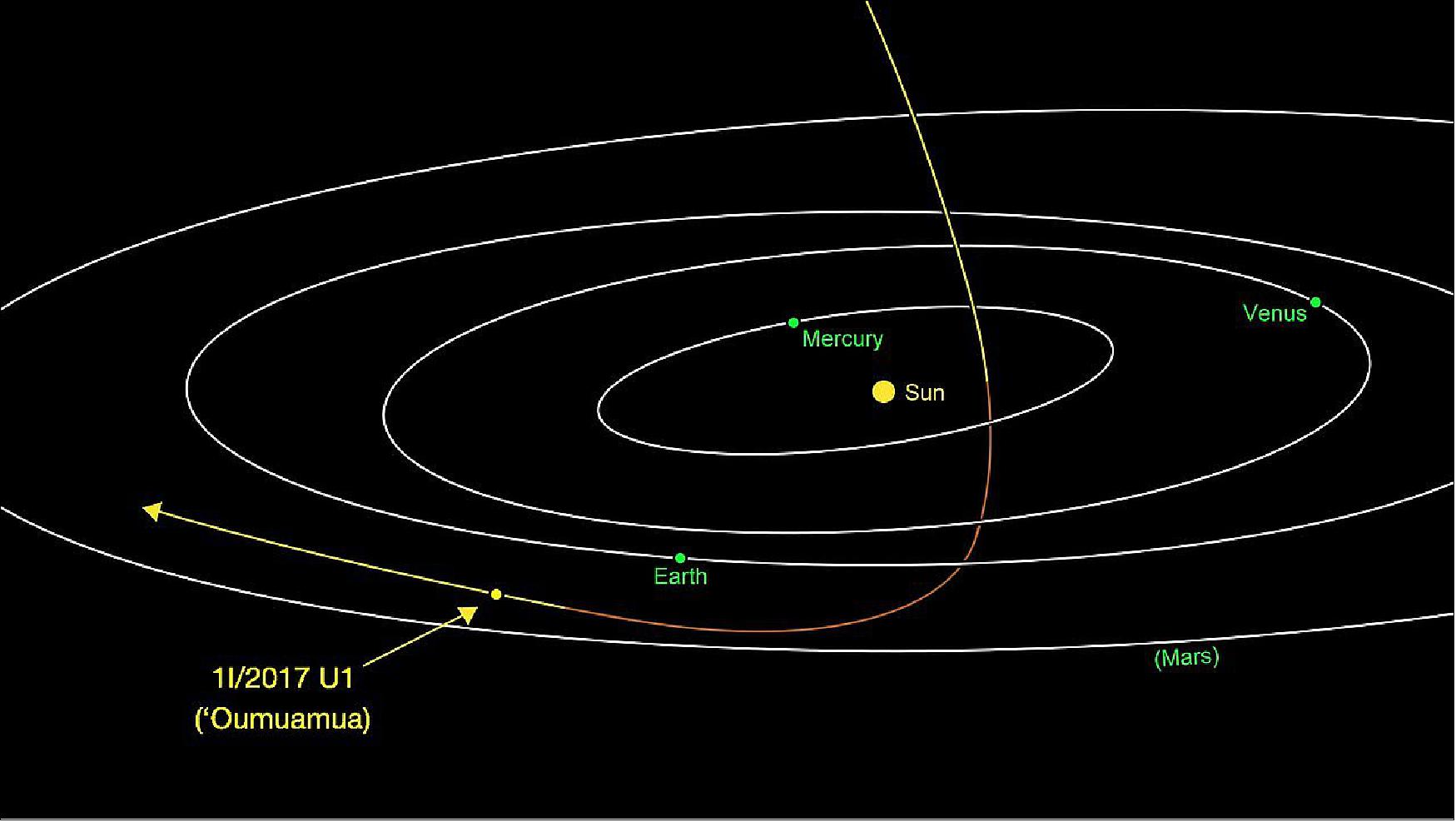
• November 1, 2017: Until very recently, all~750,000 known asteroids and comets originated in our own solar system. These small bodies are made of primordial material, and knowledge of their composition, size distribution, and orbital dynamics is essential for understanding the origin and evolution of our solar system. Many decades of asteroid and comet characterization have yielded formation scenarios that explain the mass distribution, chemical abundances and planetary configuration of today's solar system, but it has remained a mystery how typical our solar system is. 12)
- On 19 October 2017, the Pan-STARRS1 survey telescope discovered asteroid A/2017 U1, the first object known to originate outside our solar system. Follow-up observations by other observers and subsequent analysis verified the extrasolar trajectory of A/2017 U1 and reveal the object to be asteroidal, with no hint of cometary activity despite an approach within 0.25 au of the Sun after multiple solitary orbits around the galaxy at temperatures that would preserve volatile ices for billions of years. Spectroscopic measurements show that the object's surface is consistent with comets or organic-rich asteroid surfaces found in our own solar system.
- Light-curve observations of A/2017 U1 indicate that the object has an extreme oblong shape, with a 10:1 axis ratio and a mean radius of 102±4 m,and given its similar surface composition to solarsystem asteroids, suggests that such shapes are common during the formation epoch when asteroids are likely to be ejected from their solar systems.
- The discovery of A/2017 U1 suggests that previous estimates of the density of interstellar objects were pessimistically low. Imminent upgrades to contemporary asteroid survey instruments and improved data processing techniques are likely to produce more interstellar objects
in the upcoming years, creating opportunities to interrogate the mineralogical, elemental or isotopic composition of material from other solar systems.
Observations
- On 19 October 2017, the Pan-STARRS1 telescope system detected an object moving rapidly west at 6.2 degrees per day (Figure 10 a). A search of images from the previous nights found the object had also been imaged on 18 October. Additional images acquired with the Canada-France-Hawaii Telescope (CFHT) on 22 October confirmed that this object is unique, with the highest known hyperbolic eccentricity of 1:188 ±0:016. Data obtained by our team and other researchers between 14-29 October refined its orbital eccentricity to a level of precision that confirms the hyperbolic nature at ~300 σ. Designated as A/2017 U1, this object is clearly from outside our solar system (Figure 11).

The October 22 CFHT observations were tracked at the object's rate of motion and showed no evidence of cometary activity (Figure 10b) in excellent seeing (0.5''). A/2017 U1's point spread function was consistent with a stellar profile with no asymmetry and no coma, implying that it is asteroidal. Additional time-resolved sequences of images at multiple wavelengths on October 25-26 UT with the European Southern Observatory VLT (Very Large Telescope), and on October 26-27 UT with the Gemini South Telescope, further strengthened A/2017 U1's asteroidal identification (Figure 10c).
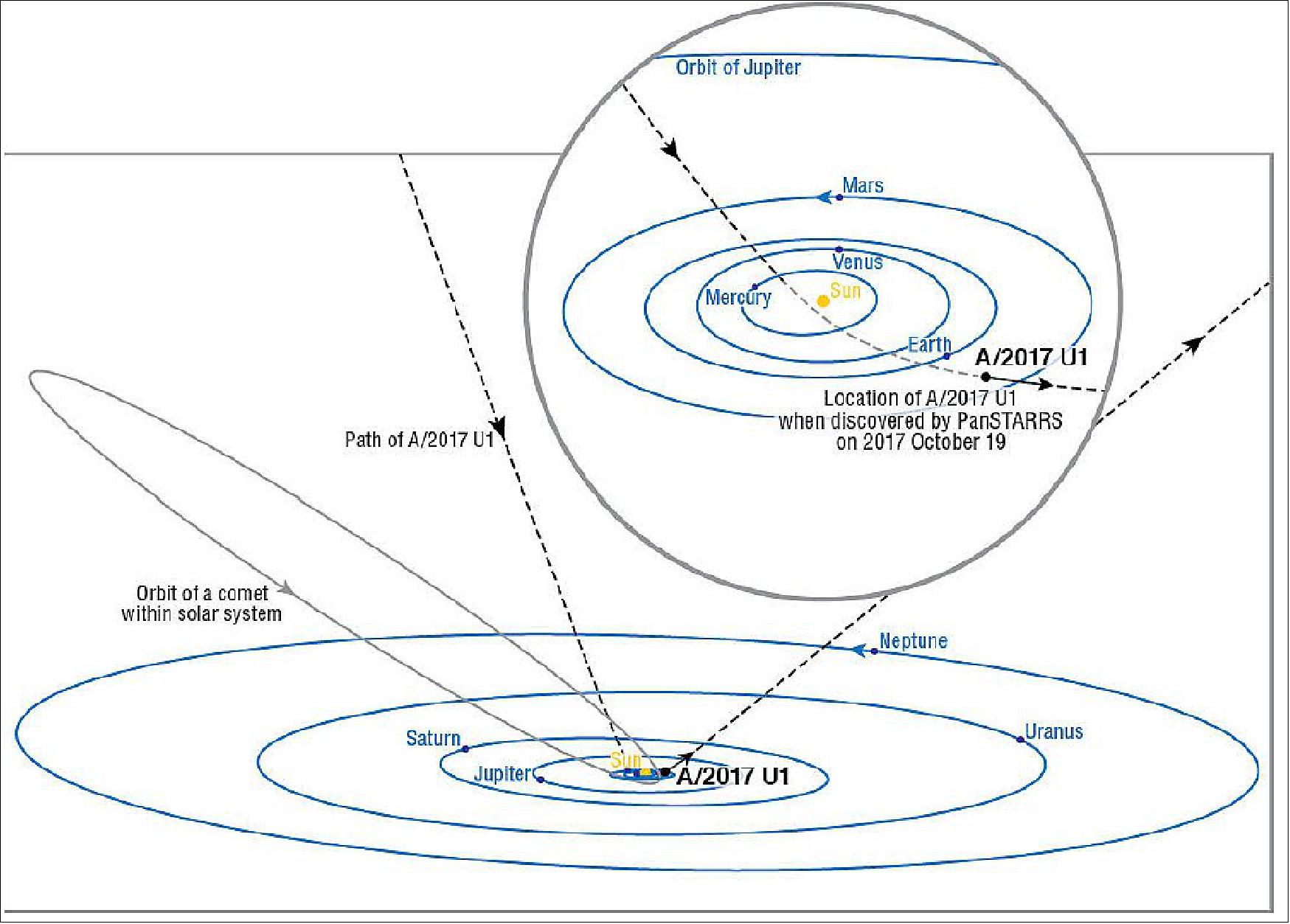
References
1) "Scientists Determine 'Oumuamua Isn't Made From Molecular Hydrogen Ice After All," Center for Astrophysics/Harvard&Smithsonian, 17 August 2020, Release No 2020-18, URL: https://web.archive.org/web/20200818184958/https://www.cfa.harvard.edu/news/2020-18
2) Thiem Hoang, Abraham Loeb, "Destruction of molecular hydrogen ice and implications for 1I/2017 U1 (‘Oumuamua)," Draft version August 13, 2020, URL: https://arxiv.org/pdf/2006.08088.pdf
3) "ASU scientists determine origin of strange interstellar object," ASU (Arizona State University) News, 16 March 2021, URL: https://news.asu.edu/20210316-asu-scientists
-determine-origin-strange-interstellar-object
4) Alan P. Jackson, Steven J. Desch,"1I/‘Oumuamua as an N2 ice fragment of an exo‐Pluto surface: I. Size and Compositional Constraints," Journal of Geophysical Research: Planets, Published: 16 March 2021, https://doi.org/10.1029/2020JE006706
5) S. J. Desch, A. P. Jackson, "1I/‘Oumuamua as an N2 ice fragment of an exo‐pluto surface II: Generation of N2 ice fragments and the origin of ‘Oumuamua," Journal of Geophysical Research: Planets, Published: 16 March 2021, https://doi.org/10.1029/2020JE006807
6) Issam Ahmed , "Harvard astronomer argues that alien vessel paid us a visit," Phys.org, 6 February 2021, URL: https://phys.org/news/2021-02-
harvard-astronomer-alien-vessel-paid.html
7) Rafi Letzter, "Mystery of Interstellar Visitor ‘Oumuamua Gets Trickier — Aliens? Or a chunk of solid hydrogen? Which idea makes less sense ," Scientific American, 19 August 2020, URL: https://www.scientificamerican.com/article/
mystery-of-interstellar-visitor-oumuamua-gets-trickier/
8) Eric Betz, "Cosmic visitor ‘Oumuamua may have been ripped from an alien world," Astronomy, 13 April 2020, URL: https://astronomy.com/news/2020/04/
interstellar-visitor-oumuamua-maybe-a-chunk-of-a-shredded-alien-world
9) "'Oumuamua is not an alien spacecraft: study," Phys.org news, 1 July 2019, URL: https://phys.org/news/2019-07-oumuamua-alien-spacecraft.html
10) The ‘Oumuamua ISSI Team (Michele T. Bannister, Asmita Bhandare, Piotr A. Dybczyński, Alan Fitzsimmons, Aurélie Guilbert-Lepoutre, Robert Jedicke, Matthew M. Knight, Karen J. Meech, Andrew McNeill, Susanne Pfalzner, Sean N. Raymond, Colin Snodgrass, David E. Trilling & Quanzhi Ye), Nature Astronomy, Vol. 3, pp: 594-602, Published: 1 July 2019, https://doi.org/10.1038/s41550-019-0816-x
11) "The IAU approves new type of designation for interstellar objects," IAU (International Astronomical Union), 14 November 2017, URL: https://www.iau.org/news/announcements/detail/ann17045/
12) Karen J. Meech, Robert Weryk, Marco Micheli , Jan T. Kleyna, Olivier Hainaut, Robert Jedicke,Richard J. Wainscoat, Kenneth C. Chambers,Jacqueline V. Keane, Andreea Petric, Larry Denneau, Eugene Magnier, Mark E. Huber, Heather Flewelling, Chris Waters, Eva Schunova-Lilly, and Serge Chastel,"Discovery and characterization of the first known insterstellar object," ESO, Draft version November 1, 2017, Submitted to Nature, URL: https://www.eso.org/public/archives/releases
/sciencepapers/eso1737/eso1737a.pdf
The information compiled and edited in this article was provided by Herbert J. Kramer from his documentation of: "Observation of the Earth and Its Environment: Survey of Missions and Sensors" (Springer Verlag) as well as many other sources after the publication of the 4th edition in 2002. Comments and corrections to this article are always welcome for further updates (eoportal@symbios.space).